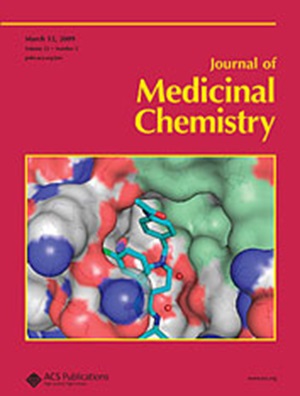Novel Carbamate-Based o-aminobenzamide Derivatives as Potent Antigastric Carcinoma Agents via Disrupting NAD+ Salvage Synthesis
IF 6.8
1区 医学
Q1 CHEMISTRY, MEDICINAL
引用次数: 0
Abstract
Blocking NAD+ biosynthesis presents an appealing strategy for antitumor therapies. This study developed a series of o-aminobenzamide derivatives with substantial antitumor efficacy against gastric cancer. Notably, compound 9a demonstrated exceptional antitumor activity against undifferentiated gastric cancer HGC27 cells (IC50 = 0.049 μM), and significant inhibitory effects on cellular proliferation, self-renewal, invasion, and migration. Mechanistic investigations revealed that 9a could damage mitochondria, arrest the cell cycle, promote apoptosis, and alter cellular metabolism. Furthermore, the rate-limiting enzyme NAMPT in the NAD+ salvage synthetic pathway was identified as a primary target of 9a. By inhibiting NAMPT, 9a reduced intracellular levels of NAD+ and ATP, while NMN, a natural product of NAMPT, counteracts its antimetabolic and cytotoxic effects. Overall, this study highlights 9a as a promising NAMPT inhibitor with significant activity against undifferentiated gastric cancer, laying the groundwork for developing novel antigastric cancer agents through inhibiting NAD+ biosynthesis.

基于氨基苯甲酰胺的新型氨基苯甲酰胺衍生物通过破坏NAD+补救性合成作为有效的抗胃癌药物
阻断NAD+生物合成是一种很有吸引力的抗肿瘤治疗策略。本研究开发了一系列对胃癌具有较强抗肿瘤作用的邻氨基苯甲酰胺衍生物。值得注意的是,化合物9a对未分化胃癌HGC27细胞表现出良好的抗肿瘤活性(IC50 = 0.049 μM),对细胞增殖、自我更新、侵袭和迁移具有显著的抑制作用。机制研究表明,9a可损伤线粒体,阻滞细胞周期,促进细胞凋亡,改变细胞代谢。此外,NAD+回收合成途径中的限速酶NAMPT被确定为9a的主要靶点。通过抑制NAMPT, 9a降低了细胞内NAD+和ATP的水平,而NMN, NAMPT的天然产物,抵消了其抗代谢和细胞毒性作用。综上所述,本研究强调9a是一种有前景的NAMPT抑制剂,对未分化胃癌具有显著的活性,为通过抑制NAD+生物合成开发新型抗胃癌药物奠定了基础。
本文章由计算机程序翻译,如有差异,请以英文原文为准。
求助全文
约1分钟内获得全文
求助全文
来源期刊

Journal of Medicinal Chemistry
医学-医药化学
CiteScore
4.00
自引率
11.00%
发文量
804
审稿时长
1.9 months
期刊介绍:
The Journal of Medicinal Chemistry is a prestigious biweekly peer-reviewed publication that focuses on the multifaceted field of medicinal chemistry. Since its inception in 1959 as the Journal of Medicinal and Pharmaceutical Chemistry, it has evolved to become a cornerstone in the dissemination of research findings related to the design, synthesis, and development of therapeutic agents.
The Journal of Medicinal Chemistry is recognized for its significant impact in the scientific community, as evidenced by its 2022 impact factor of 7.3. This metric reflects the journal's influence and the importance of its content in shaping the future of drug discovery and development. The journal serves as a vital resource for chemists, pharmacologists, and other researchers interested in the molecular mechanisms of drug action and the optimization of therapeutic compounds.
 求助内容:
求助内容: 应助结果提醒方式:
应助结果提醒方式:


